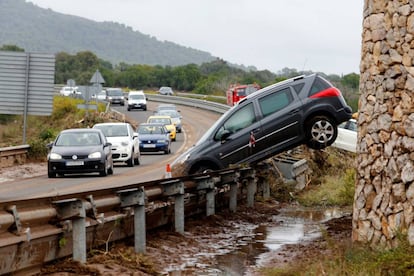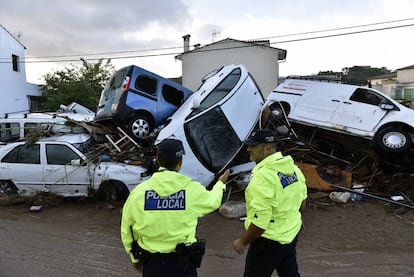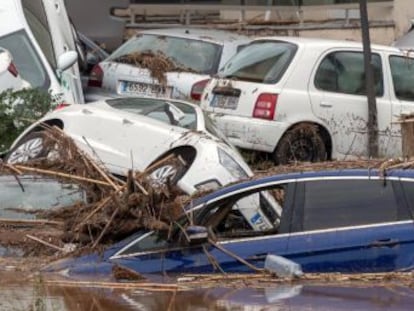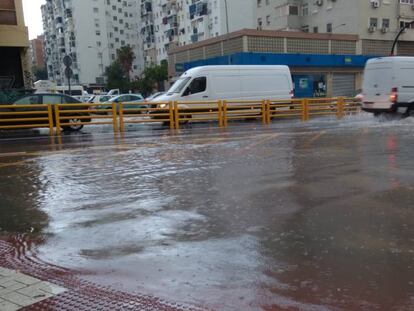Why were the floods in Mallorca so deadly?
The impact of the downpour was exacerbated by geography, infrastructure and the difficulty of forecasting the disaster


The floods that have ravaged several municipalities on the eastern coast of Mallorca, killing 10 people and causing considerable material damage, were made worse by the local geography and by a deficient water-channeling system.
Firefighters have also complained about a lack of personnel and equipment in the early hours of the rescue operation, and later, about poor coordination among the various rescue teams deployed to the area.
These are some of the factors that amplified the devastating effect of the torrential rains.
The geography of the land. The steep mountains surrounding the affected area acted as a ramp: the humid air climbed up and fed the storm that had formed on the summit. And the ravine that crosses through Sant Llorenç des Cardassar attracted most of the rain, channeling it along its bed.

Water channel. Just outside Sant Llorenç, the water is channeled by a concrete construction dating back to the late 1980s. “Concrete is less resistant to water than the natural terrain, and the current, which was carrying a large amount of mud and tree trunks, picked up speed,” explains Celso García, who teaches physical geography at the University of the Balearic Islands.
Parked cars. Many vehicles were dragged away by the fast-moving waters. Celso García said that parking should be prohibited in areas near water courses when there is a storm warning in effect. The area where Sant Llorenç and S’Illot were built has been classified as being at high risk for flooding, which means there is a chance of inundation at least once every 100 years.
Homes built in wrong places. Some homes have been built right next to water courses, and there is a church at a spot where several riverbeds meet. These are mostly old homes, not recently built ones.

Weather forecasting. Daniel Santos, a physicist and meteorology researcher, says that predicting a natural event of this magnitude is “tremendously difficult.” “The sequence [of the storm] was under the surveillance of AEMET [the Spanish meteorology agency], but some situations are highly local and time-limited. Strong storms develop in a matter of hours and involve very short-term forecasting, even though it is possible to use models.” AEMET had warned about a risk in several regions, not just the Balearics, but nowhere else was there such intense rainfall.
Short on personnel. Mallorca authorities have several fire stations distributed across the island. Of the ones nearest Sant Llorenç – located in Manacor, Felanitx and Artà – only the latter was able to send personnel following the first emergency call, which was placed at around 6.30pm. Three firefighters showed up around one hour later. Then, as the night progressed, there was “an excess of personnel” and “a lack of coordination,” according to Pere Rullán, the firefighters’ delegate at the labor union UGT.
Damage to infrastructure. Roads and bridges became impassable, hampering the rescue effort. The storm also took down telephone lines.
Lack of proper equipment. Firefighters said their efforts would have been helped by a type of four-wheel-drive vehicle known as a BRP, but there were none available at any of the three fire stations closest to the disaster zone. Firefighters in Palma de Mallorca, the island capital, have one of these vehicles and a union representative said it was hard to understand why reinforcements were sought in the mainland before asking for help from fellow officers on the island. “Several of our firefighters volunteered to help throughout the day,” said this representative.
English version by Susana Urra.
Tu suscripción se está usando en otro dispositivo
¿Quieres añadir otro usuario a tu suscripción?
Si continúas leyendo en este dispositivo, no se podrá leer en el otro.
FlechaTu suscripción se está usando en otro dispositivo y solo puedes acceder a EL PAÍS desde un dispositivo a la vez.
Si quieres compartir tu cuenta, cambia tu suscripción a la modalidad Premium, así podrás añadir otro usuario. Cada uno accederá con su propia cuenta de email, lo que os permitirá personalizar vuestra experiencia en EL PAÍS.
¿Tienes una suscripción de empresa? Accede aquí para contratar más cuentas.
En el caso de no saber quién está usando tu cuenta, te recomendamos cambiar tu contraseña aquí.
Si decides continuar compartiendo tu cuenta, este mensaje se mostrará en tu dispositivo y en el de la otra persona que está usando tu cuenta de forma indefinida, afectando a tu experiencia de lectura. Puedes consultar aquí los términos y condiciones de la suscripción digital.
More information

Flash flooding kills 12 in Mallorca
Archived In
Últimas noticias
David Bowie, the galactic thinker who encouraged us to break new ground
John Berger and the loss of rural culture
From police officer to bloodthirsty kidnapper: Terror in Mexico during the years of ‘The Ear Chopper’
Alain Aspect, Nobel laureate in physics: ‘Einstein was so smart that he would have had to recognize quantum entanglement’
Most viewed
- David King, chemist: ‘There are scientists studying how to cool the planet; nobody should stop these experiments from happening’
- Reinhard Genzel, Nobel laureate in physics: ‘One-minute videos will never give you the truth’
- Oona Chaplin: ‘I told James Cameron that I was living in a treehouse and starting a permaculture project with a friend’
- Sinaloa Cartel war is taking its toll on Los Chapitos
- Mexico completes its trade shift with the entry into force of tariffs on China and countries without trade agreements









































